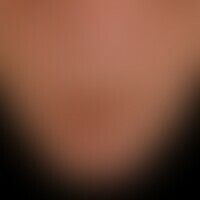Image diagnoses for "red"
876 results with 4456 images
Results forred

Hypertrophic Lichen planus L43.81
Lichen planus verrucosus: grouped, red, itchy, plaques that have existed for several months with a roughened, verrucous surface.

Folliculitis barbae L73.8
Folliculitis barbae: Chronic, therapy-resistant, inflammatory, itchy (lesions show signs of scratching) follicular papules in the area of the cheeks

Primary cutaneous diffuse large cell b-cell lymphoma leg type C83.3
Primary cutaneous diffuse large-cell B-cell lymphoma leg type: Detail magnification: Approx. 4-5 cm diameter, irregularly shaped, bulging, deep red tumor with smooth surface of a 75-year-old patient.

Rosacea fulminans L71.8
Rosacea fulminans: a peracute clinical picture with fluking, painful nodules; development of undermined ulcers.

Carcinoma of the skin (overview) C44.L
Carcinoma of the skin: a continuously growing lip carcinoma that has existed for years.

Merkel cell carcinoma C44.L
Merkel cell carcinoma: detailed image of a rapidly growing, symptomless red node.

Artifacts L98.1

Psoriasis palmaris et plantaris (plaque type) L40.3
Psoriasis palmaris et plantaris (plaque type): red and scaly, markedly indurated plaques on the palm of the hand. Sharp border to the flexor side of the forearm. This sharp transition to the unaffected skin differentiates palmar psoriasis from "hand eczema".

Basal cell carcinoma nodular C44.L
Nodular, extensive ulcerated basal cell carcinoma. since >10 years slowly growing exophytic, non-painful, fleshy tumor which was covered with a compress. marked with arrows, a glassy border wall which is (still) characteristic for advanced basal cell carcinoma.

Klippel-trénaunay syndrome Q87.2
Klippel-Trénaunay syndrome: extensive vascular malformation with extensive nevus flammeus affecting the trunk and both arms with distinct soft tissue hypertrophy of the right arm.

Erythema anulare centrifugum L53.1
Erythema anulare centrifugum: chronically active, centrifugally growing, ubiquitous (here localized on the trunk), red, smooth, solid, confluent anular plaques, the edges of which are palpable like a wet "wool thread".

Prurigo simplex subacuta L28.2
Prurigo simplex subacuata: typicaldistribution pattern of the interval-like itchy, scratched, inflammatory papules and plaques. in places the changes are also linearly arranged. numerous atrophic scars are also visible. known poorly controlled diabetes mellitus. onset of chronic terminal renal insufficiency

Ulerythema ophryogenes L66.4
Ulerythema ophryogenes: the area marked by the square shows follicular papules (keratosis follicularis) on an enlarged scale with a reddened courtyard which merges into a two-dimensional erythema.

Mallorca acne L70.8
Acne, Mallorca acne. acute (after sun exposure 14 days ago), in UV-exposed areas (especially face, upper arms, décolleté, back), 0.1-0.3 cm in size, moderately consistent, itchy, follicular, red, smooth raised areas (papules, pustules).

Parapsoriasis en plaques large L41.4
Parapsoriasis en plaques, large-hearth inflammatory form. general view: For the first time in the 39-year-old woman multiple, itchy, erythematous, brownish, partly scaly, partly confluent plaques appeared at the gluteal region during pregnancy. These spread to the legs in the course of the disease. transition from parapsoriasis en plaques to mycosis fungoides in the patch stage.

Klippel-trénaunay syndrome Q87.2
Klippel-Trénaunay syndrome: Extensive vascular malformation with a large-area nevus flammeus affecting the trunk and the right lower extremity with soft tissue hypertrophy of the right lower extremity; pelvic obliquity.

Melanoma amelanotic C43.L
Melanoma, malignant, acrolentiginous. solitary, chronically stationary, slowly increasing, localized at the right big toe, measuring approx. 0.5 cm, touch-sensitive, red node ulcerated with a dark pigmented part (see circle and arrow marking) Histology: tumor thickness 2.7 mm, Clark level IV, pT3b N0 M0, stage IIB.

Livedo racemosa (overview) M30.8
Livedo racemosa:generalized livedo racemosa with characteristic bizarre reddening of the skin, which typically does not form closed ring structures; no other organ alterations

Contact dermatitis of the scalp allergic L25.9
Severe contact allergic eczema of the scalp to a hair dye. Massive swelling of the entire scalp and eyelids.





